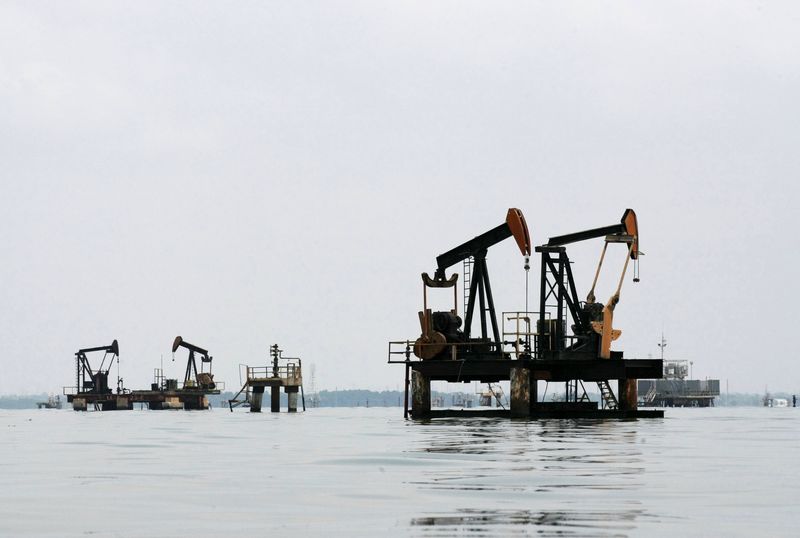(Adds short-term and long-term views on Midland grades in
paragraph 8)
HOUSTON, Oct 2 (Reuters) - Light, sweet Permian crude, under
pressure from expectations of weakening demand, began trading at
a discount to WTI for delivery at Cushing Thursday, ending its
longest-running premium to the benchmark grade.
Midland WTI WTC-WTM traded as low as 30 cents a barrel
under the WTI CLc1 benchmark Thursday, its lowest level since
June 17.
Permian crude traded at about a $20 a barrel discount to WTI
as little as three years ago and has strengthened in the past
year, supported by the development of new takeaway capacity from
the region. While Midland crude will often oscillate between a
discount and a premium to WTI, the market recently sustained a
premium for a record three and a half months.
But that ended Thursday as domestic cash crude differentials
eroded on weaker demand from refiners ahead of the fall
maintenance season. Just last week, U.S. refinery utilization
fell to 89.8 percent, its weakest level since the end of May,
according to the Energy Information Administration (EIA).
As refiners run facilities at lower rates, crude inventories
on the Gulf Coast are up sharply, rising by 5.1 million barrels
last week to 23.57 million barrels and putting further downward
pressure on grades delivered into hubs at Louisiana and Texas.
"You've got softer light sweet prices in Houston and
Nederland, so Midland needs to discount as well to stay clear,"
Dominic Haywood, an analyst with Energy Aspects, said.
At the same time, 10 days of planned maintenance on a
portion of Plains All American's Basin Pipeline between Midland,
Texas, and Colorado City, Texas in November is also pressuring
Midland lower, as those barrels will need to find a new outlet.
Near term, fundamentals may remain weak for Midland crudes
as prices for U.S. Gulf Coast grades remain weak on ample supply
and potentially back crude into the Permian. Meanwhile,
long-term demand may be bolstered by the build-out of new
pipelines backed by long-term shipper agreements.
"If all of the planned and announced pipelines come online
which aim to move Permian crude east, it looks like pipe
capacity will significantly exceed production," Haywood added.
- English (USA)
- English (UK)
- English (India)
- English (Australia)
- English (South Africa)
- English (Philippines)
- English (Nigeria)
- Deutsch
- Español (España)
- Español (México)
- Français
- Italiano
- Nederlands
- Polski
- Português (Portugal)
- Português (Brasil)
- Русский
- Türkçe
- العربية
- Ελληνικά
- Svenska
- Suomi
- עברית
- 日本語
- 한국어
- 简体中文
- 繁體中文
- Bahasa Indonesia
- Bahasa Melayu
- ไทย
- Tiếng Việt
- हिंदी
UPDATE 1-Permian crude gives up 3-month premium to WTI Cushing
Published 2015-10-02, 12:44 p/m
UPDATE 1-Permian crude gives up 3-month premium to WTI Cushing

Latest comments
Install Our App
Risk Disclosure: Trading in financial instruments and/or cryptocurrencies involves high risks including the risk of losing some, or all, of your investment amount, and may not be suitable for all investors. Prices of cryptocurrencies are extremely volatile and may be affected by external factors such as financial, regulatory or political events. Trading on margin increases the financial risks.
Before deciding to trade in financial instrument or cryptocurrencies you should be fully informed of the risks and costs associated with trading the financial markets, carefully consider your investment objectives, level of experience, and risk appetite, and seek professional advice where needed.
Fusion Media would like to remind you that the data contained in this website is not necessarily real-time nor accurate. The data and prices on the website are not necessarily provided by any market or exchange, but may be provided by market makers, and so prices may not be accurate and may differ from the actual price at any given market, meaning prices are indicative and not appropriate for trading purposes. Fusion Media and any provider of the data contained in this website will not accept liability for any loss or damage as a result of your trading, or your reliance on the information contained within this website.
It is prohibited to use, store, reproduce, display, modify, transmit or distribute the data contained in this website without the explicit prior written permission of Fusion Media and/or the data provider. All intellectual property rights are reserved by the providers and/or the exchange providing the data contained in this website.
Fusion Media may be compensated by the advertisers that appear on the website, based on your interaction with the advertisements or advertisers.
Before deciding to trade in financial instrument or cryptocurrencies you should be fully informed of the risks and costs associated with trading the financial markets, carefully consider your investment objectives, level of experience, and risk appetite, and seek professional advice where needed.
Fusion Media would like to remind you that the data contained in this website is not necessarily real-time nor accurate. The data and prices on the website are not necessarily provided by any market or exchange, but may be provided by market makers, and so prices may not be accurate and may differ from the actual price at any given market, meaning prices are indicative and not appropriate for trading purposes. Fusion Media and any provider of the data contained in this website will not accept liability for any loss or damage as a result of your trading, or your reliance on the information contained within this website.
It is prohibited to use, store, reproduce, display, modify, transmit or distribute the data contained in this website without the explicit prior written permission of Fusion Media and/or the data provider. All intellectual property rights are reserved by the providers and/or the exchange providing the data contained in this website.
Fusion Media may be compensated by the advertisers that appear on the website, based on your interaction with the advertisements or advertisers.
© 2007-2024 - Fusion Media Limited. All Rights Reserved.